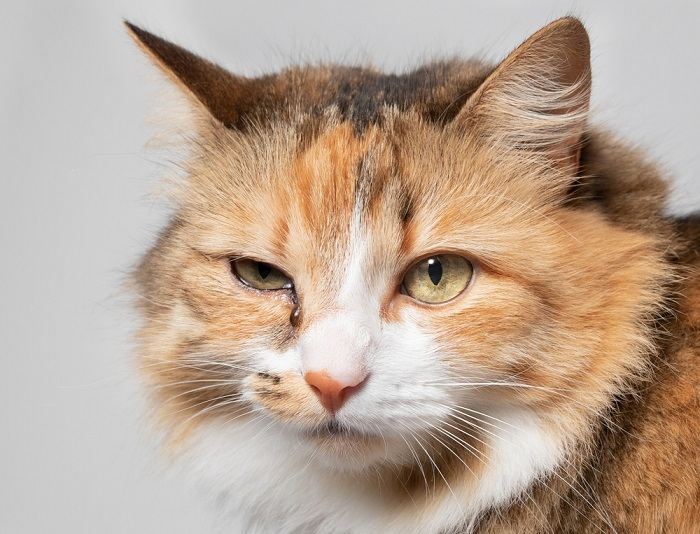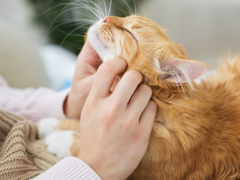
Entropion is a condition where the eyelid margin rolls inward, causing eyelashes and fur to rub on the surface of the eye. Entropion in cats can happen at any age but is most common in kittens or elderly cats.
Entropion in cats can be caused by eye infections but may also cause an eye infection or damage to the eye surface (corneal ulceration) from the rubbing fur. Treatment of entropion depends on why it happened, but it usually is a combination of medications for the eye and surgical correction of the inward rolling of the eyelids.
Quick Overview: Entropion in Cats







What Is Entropion in Cats?
Entropion occurs when the edge of the eyelid rolls inward toward the surface of the eye. Entropion causes the eyelashes and the fur on the eyelid to rub against the surface of the eye, causing irritation to the eye membranes (conjunctiva) or damage to the cornea (corneal ulceration).
Entropion can develop in either the upper eyelid or the lower eyelid but is most common in the lower lid in cats. Entropion typically occurs in young cats less than a year of age and elderly cats older than 10 years of age, but any age cat can become affected.
Causes of Entropion in Cats
Spastic Entropion
In young cats, entropion is most often caused by chronic squinting from eye infections which is called “spastic entropion”.
Kittens commonly get eye infections from viruses and bacteria which cause painful conditions like conjunctivitis and corneal ulcers.
The eye pain causes intense squinting, which eventually causes the eyelid edge to flip inward, resulting in entropion. The rubbing fur from the entropion often worsens the eye pain, causing even more squinting and worsening of the entropion, leading to a vicious cycle of pain and further damage.
Eye Sinkage Due to Age

In elderly cats, entropion most often develops due to the eye sinking deeper into the eye socket. As cats age, they lose fat and muscle from behind their eye leading to the sunken appearance of their eyes.
As the eye sinks, the eyelid edges also sink. Eventually, the sunken eyelids flip inward resulting in entropion. The irritation from the eyelid fur often causes more squinting and the entropion to worsen over time.
Eye Crowding
Cats that are brachycephalic, meaning they have short noses and bulgy eyes like Persians, Himalayans, and Burmese can have entropion related to this facial conformation. The short nose and bulgy eyes cause crowding below the eye, pushing the inner, lower eyelids towards the eyes leading to inversion of the eyelid margin and entropion.
Entropion can also be a developmental condition seen in young, un-neutered male cats of the larger cat breeds, such as Maine Coons. These cats tend to have very large jowls, or cheek tissue, and this can cause the lower eyelids to be pushed upwards towards the eyes, leading to entropion.
Is Entropion Hereditary?
Entropion is hereditary when it is caused by breed-related facial features, such as in the Persian, Himalayan, and Burmese breeds. This can also be referred to as primary entropion, meaning that it is related to the breed characteristics and was not caused by another eye problem (like conjunctivitis, for example).
Symptoms of Entropion in Cats

The symptoms of entropion in cats include squinting, a sunken appearance to the eye, and more.
Entropion causes the fur to rub on the eye surface from the inward rolling of the eyelids, causing irritation and ocular pain.
Entropion symptoms often include:
- Squinting
- Sunken appearance to the eye
- Raised third eyelid
- Pawing at the eye
- Increased tearing (epiphora) or mucoid eye discharge
- Red, puffy eye membranes (conjunctivitis)
- Haze or cloudiness to the cornea (if a corneal ulcer is occurring)
Entropion can develop in one eye or both eyes depending on the cause, and the eyes may have different symptoms if one eye is worse. Since these symptoms can develop with many different eye diseases, it is very important to have your cat examined by a veterinarian soon after symptoms start.
Entropion is diagnosed during a complete eye exam, which will also likely include a specialized green dye (fluorescein stain) test to check your cat’s eye for a corneal ulcer from the entropion.
Treatment of Entropion in Cats
Eyelid Surgery
Entropion is most often treated with eyelid surgery. While there are a few different techniques, entropion surgery involves removing a small wedge or “smile-shaped” piece of fur and skin from below the abnormal eyelid margin.
When this area is stitched closed with delicate sutures, the eyelid margin is pulled away from the eye, flipping it back into the normal position. Entropion surgery in cats has a very good success rate.
Your vet may recommend delaying entropion surgery if your cat is a young, larger breed, male cat because sometimes they will grow out of it.
Eyelid Filler Injections
Very recently, veterinary ophthalmologists have reported using a hyaluronic acid eyelid filler injection (like collagen lip injections!) to treat eyelid entropion in elderly cats.
This technique is appealing as it is usually performed without anesthesia, which can be less expensive and less risky for older cats. The outcome is much harder to predict and control, however, as compared to traditional surgical correction.
Antibiotics
Antibiotic eye medications are often used in cats with entropion to prevent a bacterial infection from developing, especially if there is a corneal ulcer. Sometimes pain medications are recommended even without surgery, but it is important to note that these are given by mouth – there are no pain-relieving eye drops for cats.
Your vet may use a numbing eye drop during the eye exam, but this cannot be used as an on-going treatment for pain.
How Much Does Entropion Surgery Cost for Cats?

Surgery is the most common treatment for entropion in cats. The price of surgery depends on a range of factors, including where you live, who performs the surgery, and how complicated the surgery will be.
The cost of entropion surgery depends on a few main factors:
- Your geographic location / cost-of-living
- Whether the surgery is performed by a general practice vet or a board-certified veterinary ophthalmologist
- If one eye (unilateral) or both eyes (bilateral) need surgery
- How complicated of an entropion surgery is required for repair
Generally speaking, routine entropion surgery for one eye performed by a general practice vet would range from a few hundred dollars to $1,000. Entropion surgery performed by a board-certified veterinary ophthalmologist may be upwards of $2,000 or more, especially if the entropion is severe or requires extensive reconstructive techniques.
These costs should include anesthesia and post-operative medications. Some veterinarians will also include the initial post-operative recheck exam with surgery fees.
Entropion in Cats Recovery
After entropion surgery for your cat, a few things are to be expected:
- Your cat will have a small incision on the eyelid skin with stitches in the skin
- Mild swelling and redness around the incision is normal for a few days after surgery. Your cat will need to wear a hard, plastic Elizabethan collar to prevent anything from touching or rubbing against the incision or eyeball, causing damage or infection. This is usually just for a few days, but your vet will provide exact guidelines
- Your cat will need eye medications, usually 2-3 times daily, after entropion surgery for 1-2 weeks
- Medications for pain and inflammation are usually given by mouth for a few days after entropion surgery
As with any surgery, it is important to monitor closely for signs of infection within the incision or on the eye. Signs to watch for include:
- Excessive swelling or redness to the incision
- Pus-like discharge from the incision or from the eye
- Squinting which is getting worse than before surgery
- Redness and puffiness to the eye membranes that is worsening
- Haze or cloudiness to the surface of the eye (cornea)
Entropion Prevention
To prevent entropion from chronic squinting, eye infections should be treated early, and you should have your cat re-evaluated if the squinting comes back at any time after treatment.
Entropion in elderly cats from sunken eyes can’t really be prevented. However, some research has shown that both eyes should have surgery even if the entropion is only in one eye.
For the eye without entropion, an eyelid shortening surgery performed at the same time can prevent entropion from developing later on.
Conclusion
Entropion in cats is a painful condition that can quickly lead to damage to the eye surface as the eyelid edge rolls in causing fur to rub against it.
Most often seen in either young kittens with eye infections and chronic squinting or elderly cats with sunken eyes due to weight loss and muscle loss, entropion requires eye medications to prevent bacterial infection and corneal ulcers. Entropion is usually best treated with entropion surgery.
Frequently Asked Questions?
How do you treat entropion in cats?
Entropion in cats is most often treated with surgery to realign the eyelid edge properly. Antibiotic eye medications may be used to treat or prevent bacterial infections on the eye surface caused by the entropion.
How much does entropion surgery cost for cats?
The cost of entropion surgery can vary depending on a lot of factors, like where you live and if the surgery is performed by a specialist. Simple entropion surgery for one eye by a general practice vet can cost as little as a few hundred dollars, whereas complicated entropion surgery performed by a board-certified veterinary ophthalmologist may be upwards of $2000 or more.
Can entropion correct itself?
Mild entropion caused by squinting might correct itself once the cause of the squinting is treated (such as conjunctivitis), however this isn’t common.
Why is my cat's third eyelid not retracting?
An elevated or raised third eyelid in a cat is usually a sign of eye pain from conditions like conjunctivitis, corneal ulcers, and entropion. When your cat experiences eye pain, they use a special muscle to pull their eye deeper into the socket, allowing the third eyelid to raise up over the eye surface to protect it.
-
Read RA, Broun HC. Entropion correction in dogs and cats using a combination Hotz-Celsus and lateral eyelid wedge resection: results in 311 eyes. Vet Ophthalmol. 2007 Jan-Feb;10(1):6-11.
-
White JS, Grundon RA, Hardman C, O'Reilly A, Stanley RG. Surgical management and outcome of lower eyelid entropion in 124 cats. Vet Ophthalmol. 2012 Jul;15(4):231-5.
-
Donnelly K. Eyelid Disorders in Dogs and Cats. In: Reinstein SL, ed. Guide to Clinical Ophthalmology. 1st ed. NAVC Media; 2019:13-34.








Thank you, this was very helpful! I am lookin at this rescue cat, and I would love to adopt him. He had the surgery. Your information may determine my decision.
My cat is amazing. You would never know he was blind in one eye.
My cat had entropion in both eyes and had the surgery. The surgery only corrected one of the eyes. He is blind in the eye where the surgery didn’t correct it.